Shillong: Cherishterfield Thangkhiew, a 54-year-old former militant, was sleeping on the top floor of his house when he was shot dead, allegedly in self-defence, during a police raid that took place at his home in Meghalaya’s Shillong in the early hours of 13 August.
During the raid, Thangkhiew’s two sons were sleeping in an adjacent room while his wife was on the ground floor in a house situated in the Mawlai region of the capital city.
Two days after his death, on 15 August, widespread violence was reported from Shillong that led to a curfew imposition and the resignation of Home Minister Lahkmen Rymbui.
According to sources in the Meghalaya Police, the raid was conducted to arrest Thangkhiew, who was the founding general secretary of the now outlawed Hynñiewtrep National Liberation Council (HNLC), a separatist outfit, but the situation escalated after he allegedly attacked a police officer with a knife.
Narrating the sequence of events, a senior Meghalaya police officer, who wished to remain unnamed, said, “They (police personnel) were calling out for him from the ground floor but because he wasn’t responding they went up and barged into his room. It was dark, Thangkhiew tried to attack them with a knife.”
The police sources said that one round was fired at his abdomen under their right of private defence — a right to protect oneself that is enshrined in the Indian Constitution. He was rushed to the Civil Hospital in Shillong but succumbed to his injuries en route.

Also read: No organised system for militancy in Meghalaya, extortion racket to blame for unrest: CM Sangma
‘Encounter was pre-planned’: Thangkhiew’s family
Thangkhiew’s family and acquaintances, meanwhile, have accused the Meghalaya Police of pre-planning a fake encounter.
Many have questioned the timing of the raid, including A.L. Hek, adviser to Chief Minister Conrad Sangma and former state health minister.
“The police should have arrested him, during normal hours, not in the dead of the night. It’s not like he was going anywhere. Everyone knows where he lives,” he told ThePrint.
The former militant’s younger brother, G. Thangkhiew also echoed the sentiment . “If they wanted to interrogate him they should have come and questioned him during the day and not during the middle of the night. I don’t agree that they found any evidence,” he said.
However, the officer quoted above explained that the raid was conducted after midnight as the police were afraid that he will destroy evidence.
According to the police, Thangkhiew was involved in two bomb blasts that had taken place in Meghalaya in July and August and the raid was conducted to arrest him in connection with the same.
“The decision to raid at night was made keeping in mind that Thangkhiew isn’t given the time to destroy evidence. We also had intel that another bomb blast was being planned in Shillong’s Police Bazar on 13 August. This coming just two days before Independence Day is why it was important to act right away,” he said, adding that the blast was averted.
The slain former militant’s family also raised doubts about Thangkhiew wielding a knife saying his health conditions restricted his movements.
A former HNLC member told ThePrint that he had a paralysed left arm and severe kidney problems, which had resulted in swollen legs that did not allow him to sleep at night or even walk properly.
Thangkhiew’s son Grainy F.G. Diengdoh claimed that there was no knife in the room when the police barged in. He further accused the police of kicking and beating him.
Grainy, along with his brother Olifin G. Diengdoh, was also allegedly picked up by the police and did not return home till 7 pm on 13 August, said a former HLNC member, who did not wish to be named.
The former militant’s family filed a complaint against the police Wednesday and an FIR on the same was registered Thursday under Section 307 (attempt to murder) of the Indian Penal Code.
The police have said that an investigation is underway.
Meanwhile, a judicial enquiry committee headed by Justice T. Vaiphel, a retired judge and Meghalaya Human Rights Commission chair, has also been set up to look into the encounter. The committee has been given a deadline of three months to submit their report.

Also read: Shillong returns to markets ‘hoping for calm’ after violence, curfew over ex-militant’s killing
What led to the ‘raid’ at Thangkhiew’s house
Thangkhiew — one of the most feared militants during his active years — ran a betel nut plantation in Bangladesh as an active member of the HNLC.
HNLC was founded in the 1980s by him alongside Julius K. Dorphang, M. Diengdoh and Bobby Marwein as a breakaway faction of the Hynniewtrep Achik Liberation Council (HALC)— which represented the Khasi, Jaintia and Garo communities.
Much like insurgency across the Northeast, separatist outfits began cropping up in Meghalaya stemming from a fear of ‘dkhars’ (outsiders) establishing dominance in the region. The HNLC — which represents the Khasi and Jaintia population — demanded independence from India while HALC wanted statehood within the Indian constitution.
In 2018, he retired from the militant group and returned to India from Bangladesh citing ill health.
“Thangkhiew made a deal with the government that promised to help him return to a normal life in India but this did not happen,” a former HNLC member told ThePrint.
After his retirement, Thangkhiew led a quiet life all through 2019 only to resurface again in 2020, according to the police.
Saińkupar Nongtrawhas, HNLC’s current general secretary-cum-spokesperson has claimed that Thangkhiew played the role of mediator between the government and the outlawed outfit.
The encounter that killed the former militant took place just three days after a low-intensity IED bomb went off in Shillong’s Laitumkhrah area, injuring two people on 10 August.
A month back, on 14 July, another bomb blast was reported from Clariet Police Reserve in Khliehriat that falls in East Jaintia Hills district where one policeman was injured and the police building was damaged.
HNLC’s Nongtrawhas claimed responsibility for both these blasts via Facebook posts. However, Thangkhiew’s name also emerged in connection with these blasts.
R. Chandranathan, Director General of Police (DGP), Meghalaya, claimed that the investigations and statements of other HNLC members, arrested in connection with the blasts, indicated that the former militant was involved.
“We found incontrovertible evidence of the involvement of Cheristerfield Thangkhiew, especially in the Khliehriat bomb blast case, and we also found his links to the Shillong blast case,” Chandranathan said in a press briefing on 13 August.
He was named in two cases registered by the police on 14 July and 10 August, respectively, and was charged under sections of the stringent anti-terror law Unlawful Activities Prevention Act and Explosives Act along with attempt to murder.
Both these cases were transferred to the Crime Branch on 11 August.
According to the police officer quoted earlier, more arrests will also be made in the blast cases once the situation in the capital calms down.

20 police personnel involved in raid
It was in connection with these two cases that 20 police officers reached Thangkhiew’s house — a three-story structure, where the second floor remains under construction — in the dead of the night.
The raid was led by East Jaiñtia Hills police chief Jagpal Singh Dhanoa and East Khasi Hills Superintendent of Police (Traffic) Shailendra Bamaniya. The aim was to arrest the former militant, who the administration claims had surrendered but the family maintains had retired due to ill health.
ThePrint reached out to the two SPs via calls and messages but did not receive a response till the time of publishing.
Ten mobile phones, a laptop, a 9 mm pistol and the knife that Thangkhiew allegedly wielded were seized from his residence, according to the police.
(Edited by Rachel John)
Also read: ‘There were bullets, stones all over’: Story of how Assam & Mizoram police fought each other



